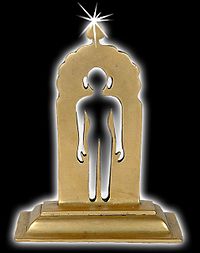Jainism and non-creationism
Jain texts claim that the universe consists of jiva (life force or souls) and ajiva (lifeless objects).
Furthermore, according to the Jain concept of divinity, any soul who destroys its karmas and desires achieves liberation (nirvana).
The theme of non-creationism and absence of omnipotent God and divine grace runs strongly in all the philosophical dimensions of Jainism, including its cosmology, karma, moksa and its moral code of conduct.
According to Jains, this loka or universe is an entity, always existing in varying forms with no beginning or end.
Jain texts describe the shape of the universe as similar to a man standing with legs apart and arms resting on his waist.
[4] This cyclic nature eliminates the need for a creator, destroyer or external deity to maintain the universe.
[10] If God is indeed the creator, then this is an impossible predication as the same cause will be responsible for two contradictory effects of cetana (life) and acetana (matter).
[11] This logically precludes an immaterial God (a conscious entity) from creating this universe, which is made up of material substances.
[15] Jainism thus lays a strong emphasis on the efforts and the free will of the soul to achieve the desired goal of liberation.
According to Jainism, gods can be categorized into Tīrthankaras, arihants or ordinary kevalins and siddhas.
Tīrthankaras are literally the ford makers who have shown the way to cross the ocean of rebirth and transmigration and hence have become a focus of reverence and worship amongst Jains.
They are not the beings who exercise any sort of creative activity or who have the capacity or ability to intervene in answers to prayers.
[19] Hence in accordance with the natural karmic laws, consequences occur when one utters a lie, steals something, commits acts of senseless violence or leads the life of a debauchee.
[19] Karmas are often wrongly interpreted as a method for reward and punishment of a soul for its good and bad deeds.
[21] Hence a soul may transmigrate from one life form to another for countless of years, taking with it the karmas that it has earned, until it finds conditions that bring about the fruits.
While Buddhism does give a similar and to some extent a matching account for Gautama Buddha, Hinduism maintains a totally different theory where "divine grace" is needed for emancipation.
It operates as a self-sustaining mechanism as natural universal law, without any need of an external entity to manage them.
12th century Ācārya Hemacandra puts forth the Jain view of universe in the Yogaśāstra thus[i] – This universe is not created nor sustained by anyone; It is self-sustaining, without any base or support Besides scriptural authority, Jains also resorted to syllogism and deductive reasoning to refute the creationist theories.
Various views on divinity and universe held by the vedics, sāmkhyas, mimimsas, Buddhists and other schools of thought were analysed, debated and repudiated by the various Jain Ācāryas.
However the most eloquent refutation of this view is provided by Ācārya Jinasena in Mahāpurāna thus[j] – If God created the world, where was he before the creation?
If he created because of the karma of embodied beings [acquired in a previous creation] He is not the Almighty Lord, but subordinate to something else.
If out of love for living beings and need of them he made the world, why did he not make creation wholly blissful free from misfortune?
The Jaina position on God and religion from a perspective of a non-Jain can be summed up in the words of Anne Vallely.
[22]Jainism, along with Buddhism, has been categorized as atheist philosophy (i.e. Nāstika darśana) by the followers of Vedic religion.
Sinclair Stevenson, an Irish missionary, declared that "the heart of Jainism is empty” since it does not depend on beseeching an omnipotent God for salvation.
A siddha is an atma which has achieved moksha and the closest approximation in English would be "liberated soul".
By Prof A. Chakaravarti, page 1 of main text – "Jainism recognizes plurality of selves not only in world of samsara but also in the liberated state or siddhahood which is a sort of a divine republic of perfect souls where each soul retains its individual personality and does not empty its contents into the cauldron of the absolute as is maintained by other systems of philosophy" e. ^ See Tattvārthasūtra 1.1 "samyagdarśanajñānacāritrānimoksamārgah" – Translated as "Rational Perception, Rational Knowledge and Rational Conduct constitutes the path to liberation."
f. ^ See Sarvārthasiddhi "Moksa mārgasya netāram bhettāram karmabhubrutām jnātāram vishva tatvānām vande tadguna labhdhaye."
Translated as "We pray to those who have led the path to salvation,who have destroyed the mountains of karma, and who know the reality of the universe.
^ This quote from Mahapurana finds a mention in “Salters Horners Advanced Physics” by Jonathan Allda, which contains various scientific theories on Universe.




